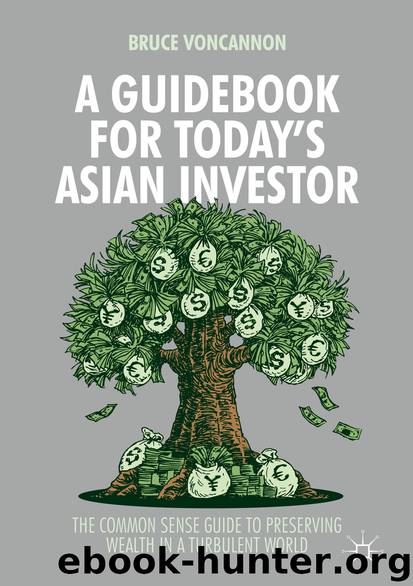A Guidebook for Today's Asian Investor by Bruce VonCannon

Author:Bruce VonCannon
Language: eng
Format: epub
Publisher: Springer Singapore, Singapore
If you like DBS Bank you might think that in return for 8% p.a., it is a safe bet. There are two scenarios under which you might decide not to invest in the PERLE . One, if you felt nervous and did not like the stock fearing it might plummet into the $8.00 range, then you might not invest in the PERLE. Or, if you really liked DBS and thought the price might go to $11 or $12 per share, then you would be better off just buying the share as such price increase would offer a potential return well above the 8% p.a. offered by the PERLE .
In summary, use of derivative strategies involves delicate pricing and timing when placing a structured product into an investment portfolio. When choosing alternative fund exposure for the portfolio, selecting more than one type of alternative fund is often a wise strategy. Reckless entrees by the investor into the derivative markets without well-conceived tactical consideration can be extremely risky and easily become destructive to one’s wealth rather than preserving it. Working with a competent wealth manager or financial broker is essential in order to pair the proper derivative exposure with your portfolio.
Volumes of books have been written on derivative products and strategies for using them. It would be impossible to cover every facet of derivative strategy in this one chapter. Computer technology and statistical analysis programs have been applied to the pricing of derivative products on trading desks for many years and incorporate sophisticated computer modules like Black-Scholes and Value at Risk (VaR). It is not necessary to memorize these theories in order to use derivative instruments to your advantage. The key thing is merely to understand in broad terms how they work to grow your wealth and mitigate against risk.
For the majority of investors it is wiser to use structured products and alternative funds as a means for having derivative exposure and for the purposes of hedging risk rather than investing directly into the naked derivative instrument. While there is often a profit built into structured products for the bank or broker that offers them, it is often worth the protection and safety that such products can offer. This can be accomplished easily by coordinating with a wealth management specialist or financial broker. Investors commonly use derivative exposure for the purpose of hedging currency positions, hedging against changes in interest rates, or protecting one’s positions in the equity markets. That being said, no doubt you will encounter speculators looking for a quick profit, and who are often assuming very high risk derivative strategies involving leverage. There is a large graveyard of failed structured product strategies and poorly used derivative strategies. There are even some well-constructed, structured products that just did not work out because market conditions changed abruptly. One should be disciplined in one’s approach to investing in structured products and diversify one’s exposure over more than one type of product idea. Winning in investing is a bit like analyzing a baseball player’s batting average.
Download
This site does not store any files on its server. We only index and link to content provided by other sites. Please contact the content providers to delete copyright contents if any and email us, we'll remove relevant links or contents immediately.
The Secrets of Successful Financial Planning by Dan Gallagher(1467)
A Knight's Reward by Catherine Kean(1297)
An American Sickness by Elisabeth Rosenthal(1218)
Against the Gods by Peter L. Bernstein(1072)
America's Bitter Pill: Money, Politics, Backroom Deals, and the Fight to Fix Our Broken Healthcare System by Steven Brill(1042)
FREAKONOMICS by levitt steven d(1035)
SuperFreakonomics by Steven D. Levitt(1030)
America's Bitter Pill by Steven Brill(1011)
Risk Management Framework by James Broad(1000)
Strategic Risk Taking: A Framework for Risk Management by Aswath Damodaran(983)
A Practical Introduction to Security and Risk Management by Bruce Oliver Newsome(980)
2019 Social Security & Medicare Facts by Michael D. Thomas(980)
Game Changers by Rudolf Taschner(945)
How Our Days Became Numbered: Risk and the Rise of the Statistical Individual by Dan Bouk(929)
The New Frontier Investors by Jagdeep Singh Bachher Adam D. Dixon & Ashby H. B. Monk(920)
The 8 Characteristics of the Awesome Adjuster by Carl van Lamsweerde(903)
SUPERFREAKONOMICS by levitt steven d(898)
The Globetrotter's Guide to Travel Insurance: Travel Smarter, Pay Less, Get the Right Coverge (The Savvy Traveler Series Book 1) by Bauche Michael & Bauche Yvonne(886)
The Advisor Playbook: Regain Liberation and Order in your Personal and Professional Life by Duncan MacPherson & Chris Jeppesen(866)
